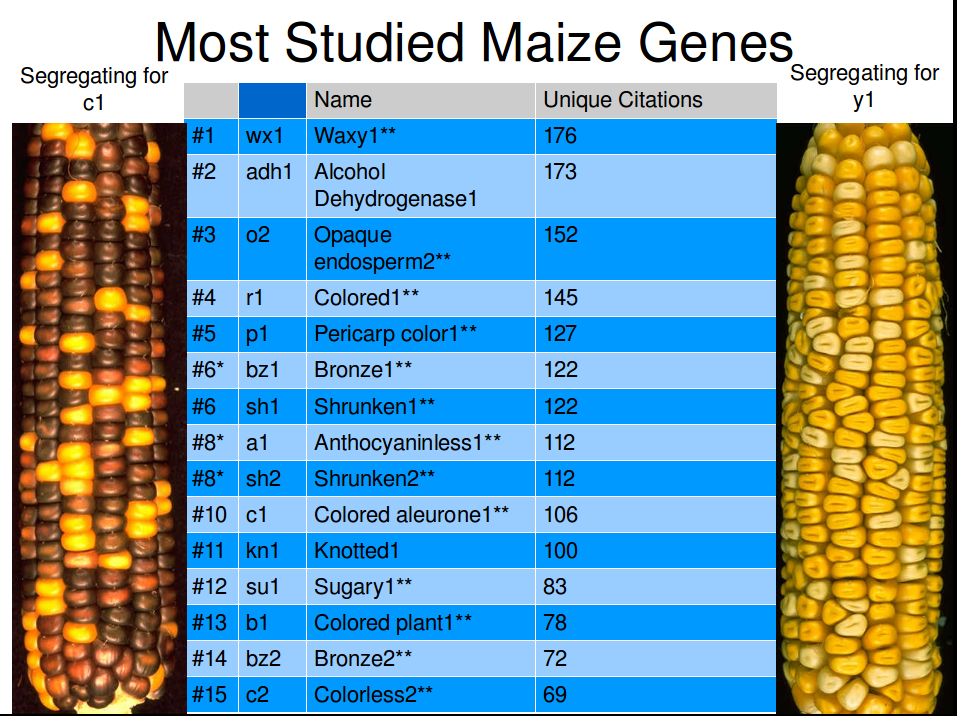Unique citations determined from papered linked to from MaizeGDB gene locus pages. Images of c1 and y1 segregating years by Gerald Neuffer and made available through MaizeGDB.
* = tied for number of citations
** = some mutant alleles have kernel phenotypes.
If you want to become one of the famous mutant corn genes, it helps if you have an effect that is visible in corn kernels instead of only from fully grown plants.
And here is why:
- A geneticist could determine that the version of c1 that creates yellow kernels is recessive to the version that creates purple kernels just from looking at the ear of corn on left.
- Furthermore, they could tell you that both the male parent (the plant that provided the pollen) and the female parent (the plant on which the ear of corn grew) were both heteryzygous for the c1 genes (they each had one dominant version of the genes and one recessive version), and therefore the corn kernels the parent plants were grown from were both purple.
- They would know with certainty that all of the yellow kernels contain two recessive versions of the c1 gene.
- While they couldn’t predict with absolute certainty whether a specific purple corn kernel on that ear carried two dominant versions of the c1 gene or one dominant and one recessive version, they would know there was a 1/3 chance that kernel has two dominant copies, and a 2/3 chance it had one dominant and one recessive copy.
- That geneticist could make all sorts of predictions about what ears would look like in future generations depending on what colors of corn kernels were planted and which plants were mated with each other.
All this from a single picture of an ear of corn. For a phenotype seen in corn plants but not in kernels (like Knotted1), a geneticist would have to plant a row or more of corn seeds from an ear and examine the growing plants to get the same quantity of information.
And that is why mutations with kernel phenotypes have been so popular over a century of maize genetics research.

I’d state it as prescreening on the ear can save you a generation, but I’m biased. There’s a typo in your table at #3 (the numbers don’t match).
Comment by Ron — March 3, 2010 @ 5:15 am
I’d describe it as either costing time (generations) or field space and work (doing lots of crosses that MIGHT be the one you want, and planting them all out the next year before you know which ones actually had the genotypes you needed.)
Good catch on opaque endosperm2, I’ve corrected the mistake in the table.
Comment by James — March 3, 2010 @ 1:50 pm
Question about kernel color: I’ll be the first to admit that I know jack squat about the grasses, so this might be one of those silly questions, but I’ve always wondered why there’s not many colorful sweet corns (besides possibly Ruby Queen, you can supposedly eat that one while it is red [I’ll have to grow that some time and find out], and I guess Black Aztec, although apparently you need to eat it before it turns black). Is there some sort of issue that makes it difficult to cross the two two types and breed until you’ve got one that’s both colorful and able to be eaten like a sweet corn? It’d be neat to see some corn on the cob with the color of corns like Earth Tones dent.
Comment by Party Cactus — March 4, 2010 @ 8:10 pm
Party Cactus,
I know this is a late reply, but yes there are some varieties of sweet corn that are multicolored. For the most part, the colors don’t come in until the sugar starts being converted into starch.
Try searching for “Astronomy Domine” sweet corn on the Homegrown Goodness plant forum.
Comment by Andrew — February 17, 2011 @ 10:38 pm
Thanks for all information about maize. That is good information.
but, can you help me Mr.?
would you explain me about the purple color kernel controlled gen of maize?
I need it, be a research material for my study in indonesian.
Please send me the information about it in my email.
Thanks a lot.
Comment by yefta — May 30, 2010 @ 10:41 pm
Dear James,
Can you help me to send the colored kernel phenotypes of maize for me? or tell me how to find the data.thanks!
best Regards1
TANG Qi-lin
Maize Research Institute, Sichuan Agriculture University, Ya-an, Sichuan 625014, R. P. China
Comment by TANG Qi-Lin — June 9, 2010 @ 3:16 am